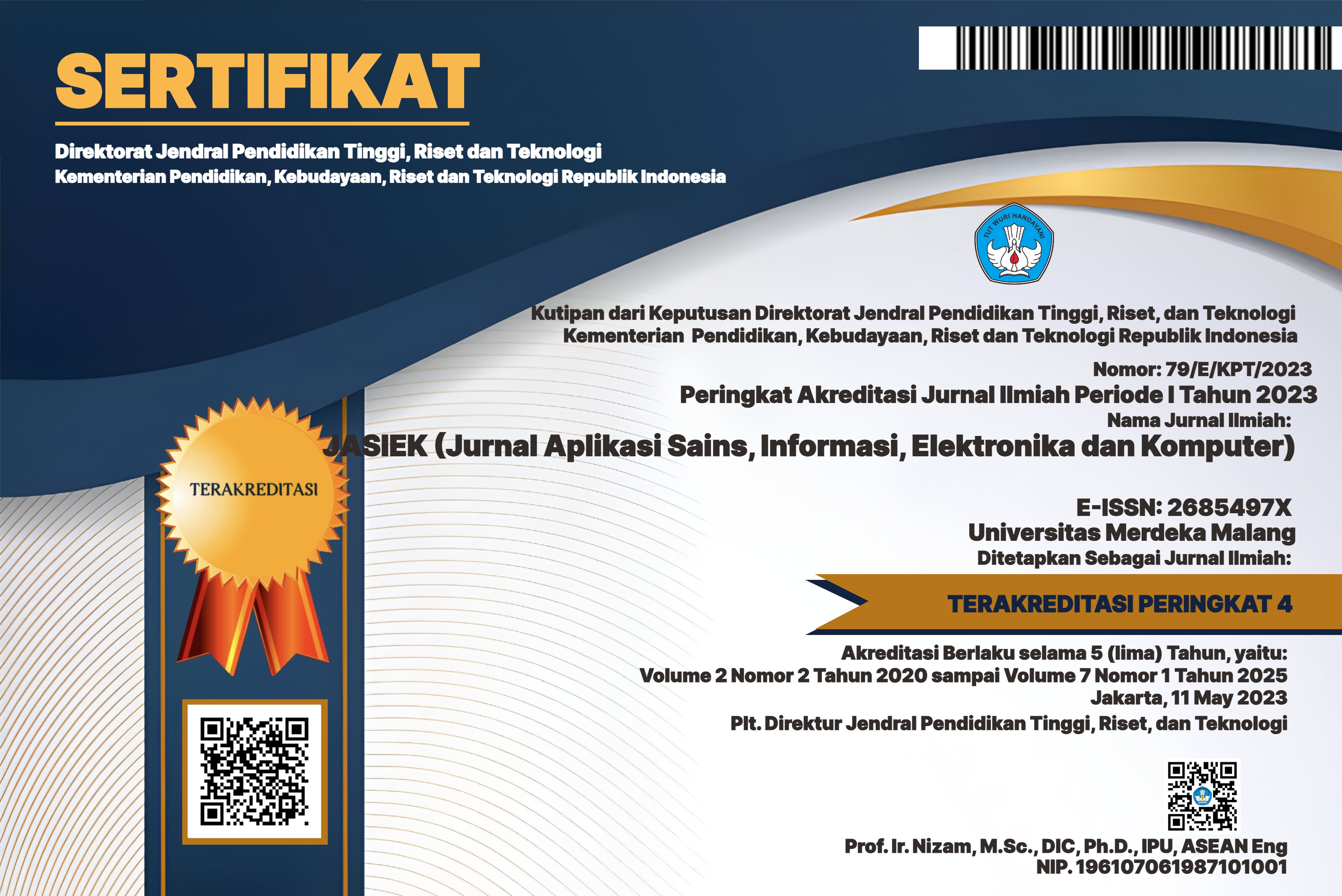OPTIMASI KERJA PELUNCUR ROKET PADA ROBOT RODA RANTAI UNTUK MENENTUKAN KETEPATAN SUDUT TEMBAK
DOI:
https://doi.org/10.26905/jasiek.v1i1.3149Abstract
Pada perkembangan teknologi saat ini banyak dikembangkan jenis robot dengan kemampuan yang menarik adalah robot dengan berbagai macam model dan bentuk karakteristiknya. Pada saat ini peluncur roket masih dikendalikan oleh manusia yang memanfaatkan teknologi dengan menggunakan pc dan motor servo sebagai alat pengendali untuk menentukan ketepatan pada sudut tembaknya, dalam merancang robot ini dibutuhkan kelengkapan komponennya agar robot dapat bekerja secara otomatis sesuai dengan masukan yang diberikan, robot peluncur roket dikendalkan secara otomatis dengan komunikasi dari pc kemudian perintah tersebut diteruskan ke mikrokontroler menggunakan kabel USB TTL kemudian dikirim ke rangkaian Xbee-pro pengirim kemudian dipancarkan dan di terima oleh Xbee-pro penerima kemudian di transmisikan ke mikrokontroler dan diolah menuju ke sistem kendalinya yang berupa motor servo dan relay sebagai komponen pada bagian penembakan peluncur roketnya. Berdasarkan hasil pengujian robot telah mampu mengarahkan peluncur roket tepat pada sudut yang sudah ditentukan dan telah mampu melakukan aksi penembakan pada tiap peluncurnya dengan tingkat keberhasilan mencapai 80%.
Â
Downloads
References
R. M. Murray, Z. Li, and S. Shankar Sastry, A mathematical introduction to robotic manipulation. 2017.
D. Saputra, D. Cahyadi, and A. H. Krisdalaksana, “Sistem Otomasi Perpustakaan Dengan Menggunakan Radio Frequency Identification ( RFID ),†Inform. Mulawarman J. Ilm. Ilmu Komput., 2010.
R. A. Brooks, “A Robust Layered Control System For A Mobile Robot,†IEEE J. Robot. Autom., 1986.
B. Arthayaa, A. Sadiyokob, and C. Wiejaya, “Pengembangan Algoritma Pengenalan Bentuk dan Arah Objek pada Sistem Omnidirectional Vision Sensor,†J. Tek. Elektro, 2013.
I. Mujahidin, R. Yuwono, and A. Mustofa, “Rancang Bangun Rectifier Antenna Mikrostrip UFO Pada Frekuensi Ultra Wideband (UWB) Sebagai Pemanen Energi Elektromagnetik,†J. Mhs. TEUB, vol. 3, no. 2, 2015.
I. Oktariawan, Martinus, and Sugiyanto, “Pembuatan Sistem Otomasi Dispenser Menggunakan Mikrokontroler Arduino Mega 2560,†J. FEMA, 2013.
R. Yuwono, I. Mujahidin, A. Mustofa, and Aisah, “Rectifier using UFO microstrip antenna as electromagnetic energy harvester,†Adv. Sci. Lett., 2015.
A. N. Putri, “Penerapan Fuzzy Controller Untuk Pergerakan Player Pada Game Engine 3d Berbasis Agen Cerdas,†J. Transform., 2017.
I. Mujahidin, “Directional 1900 Mhz Square Patch Ring Slot Microstrip Antenna For Wcdma,†JEEMECS (Journal Electr. Eng. Mechatron. Comput. Sci., 2019.
D. I. Pratiwi, M. Rivai, and F. Budiman, “Rancang Bangun Deteksi Jalur Pipa Terpendam Menggunakan Mobile Robot dengan Metal Detector,†J. Tek. ITS, 2017.
Mujahidin, I., Pramono, S. H., & Muslim, A. (2018, October). 5.5 Ghz Directional Antenna with 90 Degree Phase Difference Output. In 2018 Electrical Power, Electronics, Communications, Controls and Informatics Seminar (EECCIS) (pp. 224-228). IEEE.
M. Octavian, Ari; Darmawan, Hofman; Nurohmah, Hidayatul; Ali, “Optimasi Dual Axis Tracking Untuk Photovoltaic Berbasis Firefly Algorithm dan Ant Colony Optimization,†SinarFe7, 2018.
Downloads
Published
Issue
Section
License
Authors who publish with this journal agree to the following terms:
The journal allow the authors to hold the copyright without restrictions and allow the authors to retain publishing rights without restrictions.
Authors retain copyright and grant the journal right of first publication with the work simultaneously licensed under a Creative Commons Attribution-ShareAlike 4.0 International License that allows others to share the work with an acknowledgement of the work's authorship and initial publication in this journal.
Authors are able to enter into separate, additional contractual arrangements for the non-exclusive distribution of the journal's published version of the work (e.g., post it to an institutional repository or publish it in a book), with an acknowledgement of its initial publication in this journal.
Authors are permitted and encouraged to post their work online (e.g., in institutional repositories or on their website) prior to and during the submission process, as it can lead to productive exchanges, as well as earlier and greater citation of published work (See The Effect of Open Access).

This work is licensed under a Creative Commons Attribution-ShareAlike 4.0 International License.










